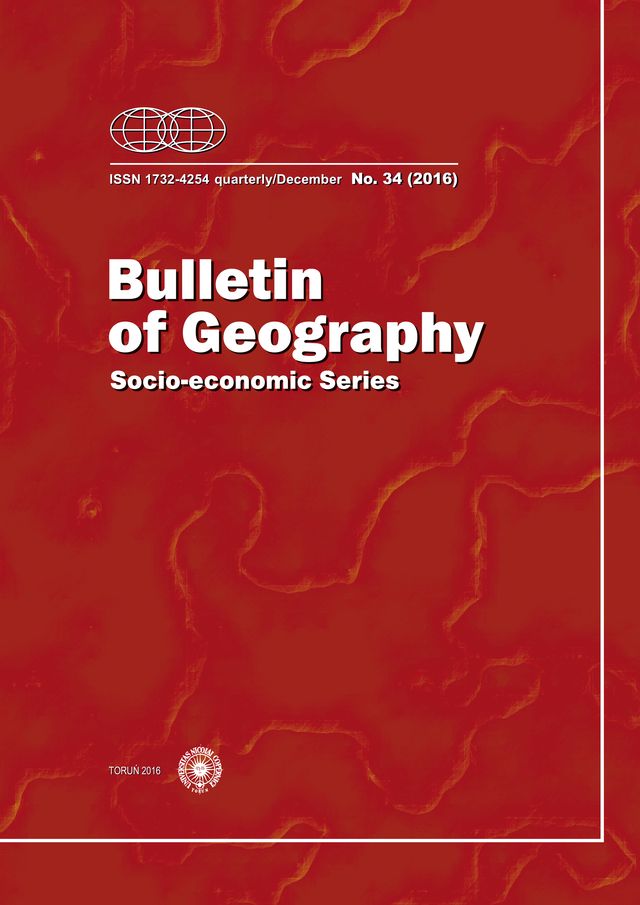The capital agglomeration of the Republic of Korea as a fuzzy central place system
DOI:
https://doi.org/10.1515/bog-2016-0031Abstract
Explosive urbanization in the Republic of Korea from 1950 to 2010 marked by a growth in extensive urban agglomerations rendered unproductive the approach that was commonly used in the central place theory and which considered every element of the settlement system as a point in a homogeneous space. The paper suggests an alternative concept of fuzzy central place that makes possible the understanding of an internal heterogeneity in the distribution of central functions within the limits of urban agglomerations. This research was conducted using the example of the Capital agglomeration - the main element of the Republic of Korea's urban settlement system. This "island" country, isolated by North Korea, has seen fantastic economic growth in the second half of the 20th century.References
Berry, B., 1960: The Impact of Expanding Metropolitan Communities upon the Central Place Hierarchy. In: Annals of the Association of American Geographers, Vol. 50, No. 2, pp. 112-116. DOI: http://dx.doi.org/10.1111/j.1467-8306.1960.tb00338.x
Berry, B. and Garrison, W., 1958: The Functional Bases of the Central Place Hierarchy. In: Economic Geography, Vol. 34, No. 2, pp. 145-154. DOI: http://dx.doi.org/10.2307/142299
Carol, H., 1960: The Hierarchy of Central Functions within the City. In: Annals of the Association of American Geographers, Vol. 50, No. 4, pp. 419-438. DOI: http://dx.doi.org/10.1111/j.1467-8306.1960.tb00359.x
Christaller, W., 1966: Central place in Southern Germany. N.J.: Englewood Cliffs.
Dacey, M.F., 1966: Probability model for central place locations. In: Annual of the Association of American Geographers, Vol. 56, No. 3, pp. 549–568. DOI: http://dx.doi.org/10.1111/j.1467-8306.1966.tb00579.x
Database of Korean Statistical Information Service, available at: http://kosis.kr/statisticsList/statisticsList_03List.jsp?vwcd=MT_RTITLE&parmTabId=M_03_01, DoA: 09 December 2013.
Database of World Factbook, available at: www.cia.gov/library/publications/the-worldfactbook/geos/hk.html, DoA: 15 March 2014.
Em, P.P., 2013: Primeneniye pravila “rang-razmer” dlya system razmitih centralnih mest (na primere novih industrial’nih stran) (Applying of rank-size rule for fuzzy central place system (the case of new industrialized countries – in Russian). In: Regional Researches, No. 2, pp. 56–59.
Hanguk Dosi Yongam 2000 (Municipal Statistic Yearbook of Korea 2000 – in Korean), Seoul: Ministry of Public Administration and Security.
Hanguk Dosi Yongam 2005 (Municipal Statistic Yearbook of Korea 2005 – in Korean), Seoul: Ministry of Public Administration and Security.
Hanguk Dosi Yongam 2009 (Municipal Statistic Yearbook of Korea 2009 – in Korean), Seoul: Ministry of Public Administration and Security.
Isard, W., 1971: Spatial interaction analysis: Some Suggestive thoughts from general relativity physics. In: Papers in Regional Science: Journal of the Regional Science Association International, Vol. 27, pp. 17-38. DOI: http://dx.doi.org/10.1007/BF01954597
Korea Statistical Yearbook 1952, 1953, Seoul: Bureau of Statistics.
Korea Statistical Yearbook 1990, 1990, Seoul: National Bureau of Statistics.
Korea Statistical Yearbook 2000. 2000, Seoul: Korea National Statistic Office.
Korea Statistical Yearbook 2011, 2011, Seoul: National Statistical Office of the Republic of Korea.
Lösch, A., 1967: The economics of location. New York: John Wiley Science Edition.
Mulligan, G.F., 1984: Central Place Populations: Some Implications of Consumer Shopping Behavior. In: Annals of the Association of American Geographers, Vol. 74, No. 1, pp. 44-56. DOI: http://dx.doi.org/10.1111/j.1467-8306.1984.tb01433.x
Polyan, P.M., 1988: Metodika videleniya opornogo kaROKasa rasseleniya (The Methodic of detection and analysis of settlement support frame – in Russian), Moscow: Institute of Geography of Academy of Sciences of USSR.
Pred, A., 1973: Systems of cities and information flows. In: Lund Studies in Geography. Ser. B. Human geography, No. 38, pp. 12-82.
Shuper, V.A., 1995: Samoorganizatsiya gorodskogo rasseleniya (Self-Organization of Urban Population – in Russian). Moscow: Russian Open University.
Ullman, E.L., 1980: Geography as Spatial Interaction. University of Washington Press.
Vazhenin, A.A., 1997: Evolusionniye processi v sistemah rasseleniya (Evolution processes in settlement systems). Yekaterinburg: Ural branch of Russian academy of Sciences.
World Urbanization Prospects: The Revision of 2011. http://www.un.org/en/development/desa/population/publications/pdf/urbanization/WUP2011_Report.pdf , DoA: 12 July 2012.
Zipf, G., 1949: Human behavior and the principle of least effort. Cambridge, M.I.T. Press, XI.
Downloads
Published
How to Cite
Issue
Section
License
Title, logo and layout of journal Bulletin of Geography. Socio-economic Series are reserved trademarks of Bulletin of Geography. Socio-economic Series.Stats
Number of views and downloads: 361
Number of citations: 1



